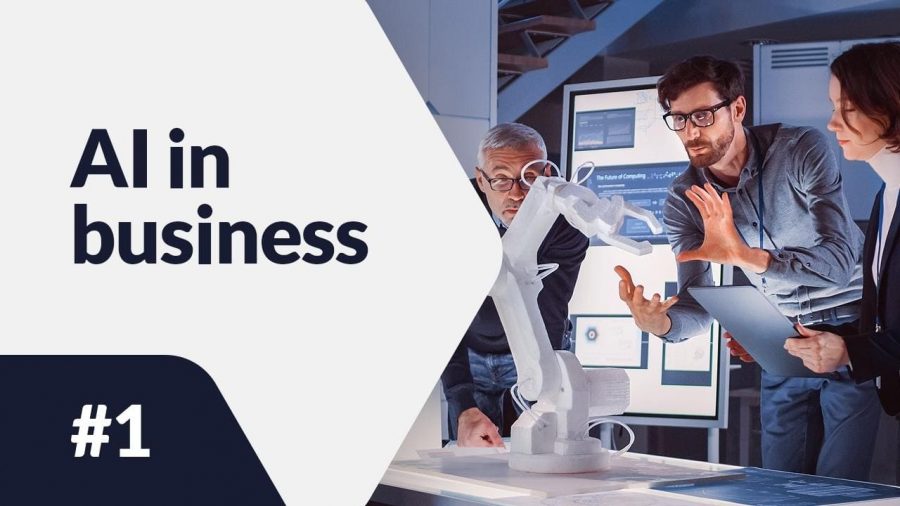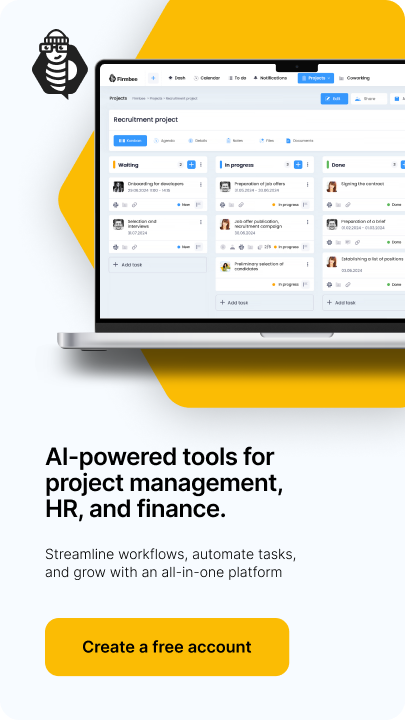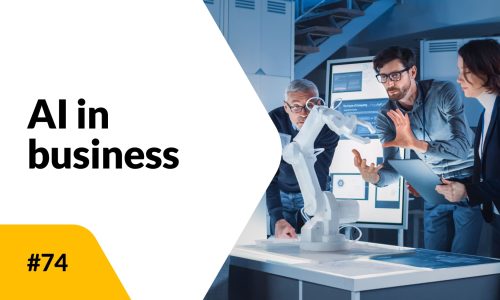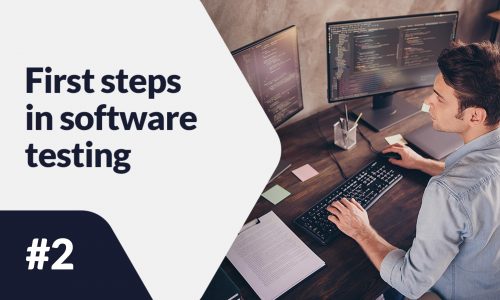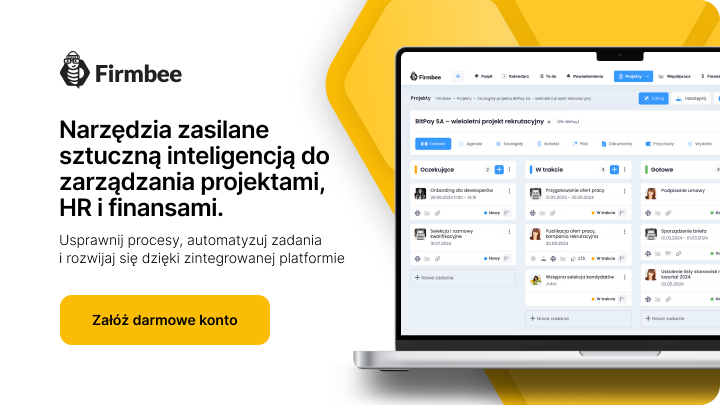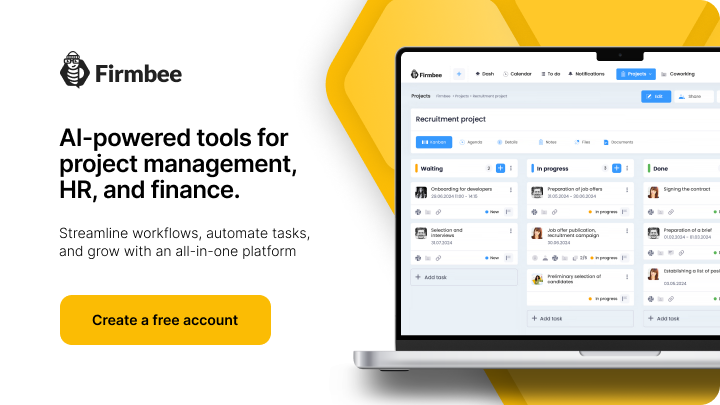Artificial intelligence in business ensures that your customer gets an instant response from customer service. Perfectly-timed marketing messages, and always up-to-date information about the status of a shipment a customer ordered in the middle of the night? These are also tasks for AI-based business tools. But how can the dynamics of AI help your company achieve market success?
Artificial intelligence in business – table of contents:
Artificial intelligence in business
To realize the full potential of artificial intelligence in your business, a strategic approach is key. First, carefully analyze your business needs and answer the questions:
- What goals do I want to achieve with AI?
- Where in my company will technology benefit the most and save the most time or money?
- How will I measure the effects of implementation?
In this way, it will be easier to choose the right AI tools and applications to help improve company results. But which solutions should you pick?
4 examples of AI application in business
In the business context, artificial intelligence is most often used for:
- Improving the customer experience,
- Personalization of marketing,
- process automation, and to
- Analyzing data to make business decisions.
So let’s take a closer look at each of them.
Improve customer service with artificial intelligence
One of the most popular applications of AI in business is customer service. AI can be applied to create chatbots and virtual assistants that will: answer customer questions, solve problems and acquire new leads by answering questions from potential customers.
So if your goal is to improve customer service, you may decide to implement a chatbot. They are available 24/7 and can provide detailed, comprehensive answers.
But they also facilitate interactions between a customer and a customer service representative by preparing a summary of previous conversations, suggesting articles from a help database, or suggesting solutions to a problem the customer is facing.
Some of the most popular solutions using artificial intelligence in business for customer service include:
- Intercom,
- Sentione, and
- InteliWISE / Efecte.
These solutions have built-in analytics modules to track the number of queries and resolved cases, so measuring the effects of implementing such artificial intelligence in business will be relatively easy.
Streamlining marketing with AI
Artificial intelligence in business also makes it possible to create personalized marketing campaigns that better address customer needs and preferences. With machine learning algorithms analyzing data and searching for patterns of consumer behavior, a company gains insight into customers’ interests. And AI will allow them to display recommendations and ads that are most relevant to them.
This is done by platforms such as:
- Sembot, which also works as a plugin for ChatGPT,
- Hubspot, which exploits AI to improve data management, SEO analysis, or personalization of displayed content.
However, AI in marketing is not just about analyzing consumer behavior, personalization and recommendations. If you intend to improve the quality of your published content or build your brand image as an expert in the industry, consider using generative artificial intelligence in business. This is because it supports the work of marketing content creators. There is even a new profession of prompt engineers writing textual cues that allow generation:
- images – in Midjourney, Dall-E, or Stable Diffusion,
- advertising texts – whether in ChatGPT like Jasper or Copy.ai, and
- video – from Colossyan to Gen-2.
In turn, another future application of artificial intelligence in business is the development of content creation processes that take advantage of the cooperation of humans and artificial intelligence and allow the creation of multimedia wholes.
Work faster with automation
Does your company perform a lot of repetitive tasks, and projects vary little from one another? Process automation is another area where artificial intelligence excels. Let’s start with simple tasks, such as:
- Spell check, for example, in Grammarly,
- Sending personalized newsletters, as in MailerLite,
- Software testing, for example, in Catalon.
And let’s finish with the complicated ones, which include Amazon’s supply chain optimization, where artificial intelligence analyzes demand and supply data, plans routes and schedules to minimize costs and waste. And recruitment, where AI systems such as Skillate can pre-analyze hundreds of resumes and select the best candidates who meet specific criteria.
Effectively analyze business data
According to a McKinsey Global Institute report titled “The economic potential of generative AI. The next productivity frontier,” one of the most important improvements brought by the application of artificial intelligence in business is the development of business strategies. This is because it makes it possible to collect and combine data from different, even seemingly unrelated sources to develop an effective business development plan. For example, it can help:
- accurately price the implementation of tasks in the project,
- prepare data visualization,
- write a report based on unstructured information.
Tools such as:
- Microsoft Power BI,
- Tableau, and
- Google Bard, which allows you to export the table straight into Google Documents.
With these tools, you can improve the efficiency of your company’s operations on a monthly or annual basis.
New products and services based on AI
But artificial intelligence in business isn’t just about improving versions of existing tools and streamlining the way companies operate. It’s also entirely new AI-based products and services:
- Autonomous cars – are still in development, but have the potential to revolutionize the transportation industry. Image recognition and real-time data interpretation are at the heart of the technology that allows autonomous cars to drive safely and efficiently,
- AI as a Service (AIaaS) – since artificial intelligence technologies in business are expensive, companies can rent specific AI-based solutions instead of investing in their own. This gives even small businesses access to advanced solutions.
- Smart appliances – thanks to artificial intelligence, not only refrigerators or washing machines but also industrial machines can optimize their performance and send data to the manufacturer or control panel.
Opportunities and threats of artificial intelligence in business
AI is a disruptive technology, that is, one that has the potential to turn many industries on their heads. It poses certain risks, but at the same time offers new and unexpected opportunities. The advantages of AI include, first and foremost:
- digital security,
- advanced monitoring,
- quick access to information,
- intuitive voice and image search.
AI solutions allow better analysis of data and understanding of customer needs. Based on this, the company can improve products or target ads more accurately.
However, there are concerns about the security of sensitive data used by AI algorithms. This is because AI can be used to generate fake news, create deepfakes and other forms of manipulation, which is particularly dangerous given the use of AI in business.
Also, the potential for automation of repetitive tasks is causing concern in the labor market. Companies must therefore responsibly plan for AI implementation, taking into account both the benefits, potential risks and the compliance of the implemented solutions with emerging regulations.
How to use artificial intelligence in business?
Artificial intelligence (AI) is an integral part of modern business, transforming many aspects of a company’s operations, from customer service to marketing and automation to data analytics.
The use of AI in business is not only to improve existing processes but also to create new products and services. However, to take full advantage of AI’s potential, a strategic approach and a thorough analysis of business needs are key. So think about what goals you want to achieve with AI, where in your company the technology will bring the most benefit and how to measure the effects of its implementation.

Read also: Digital twins. When Black Mirror becomes a reality
If you like our content, join our busy bees community on Facebook, Twitter, LinkedIn, Instagram, YouTube, Pinterest.
Author: Robert Whitney
JavaScript expert and instructor who coaches IT departments. His main goal is to up-level team productivity by teaching others how to effectively cooperate while coding.
AI in business:
- Threats and opportunities of AI in business (part 1)
- Threats and opportunities of AI in business (part 2)
- AI applications in business - overview
- AI-assisted text chatbots
- Business NLP today and tomorrow
- The role of AI in business decision-making
- Scheduling social media posts. How can AI help?
- Automated social media posts
- New services and products operating with AI
- What are the weaknesses of my business idea? A brainstorming session with ChatGPT
- Using ChatGPT in business
- Synthetic actors. Top 3 AI video generators
- 3 useful AI graphic design tools. Generative AI in business
- 3 awesome AI writers you must try out today
- Exploring the power of AI in music creation
- Navigating new business opportunities with ChatGPT-4
- AI tools for the manager
- 6 awesome ChatGTP plugins that will make your life easier
- 3 grafików AI. Generatywna sztuczna inteligencja dla biznesu
- What is the future of AI according to McKinsey Global Institute?
- Artificial intelligence in business - Introduction
- What is NLP, or natural language processing in business
- Automatic document processing
- Google Translate vs DeepL. 5 applications of machine translation for business
- The operation and business applications of voicebots
- Virtual assistant technology, or how to talk to AI?
- What is Business Intelligence?
- Will artificial intelligence replace business analysts?
- How can artificial intelligence help with BPM?
- AI and social media – what do they say about us?
- Artificial intelligence in content management
- Creative AI of today and tomorrow
- Multimodal AI and its applications in business
- New interactions. How is AI changing the way we operate devices?
- RPA and APIs in a digital company
- The future job market and upcoming professions
- AI in EdTech. 3 examples of companies that used the potential of artificial intelligence
- Artificial intelligence and the environment. 3 AI solutions to help you build a sustainable business
- AI content detectors. Are they worth it?
- ChatGPT vs Bard vs Bing. Which AI chatbot is leading the race?
- Is chatbot AI a competitor to Google search?
- Effective ChatGPT Prompts for HR and Recruitment
- Prompt engineering. What does a prompt engineer do?
- AI Mockup generator. Top 4 tools
- AI and what else? Top technology trends for business in 2024
- AI and business ethics. Why you should invest in ethical solutions
- Meta AI. What should you know about Facebook and Instagram's AI-supported features?
- AI regulation. What do you need to know as an entrepreneur?
- 5 new uses of AI in business
- AI products and projects - how are they different from others?
- AI-assisted process automation. Where to start?
- How do you match an AI solution to a business problem?
- AI as an expert on your team
- AI team vs. division of roles
- How to choose a career field in AI?
- Is it always worth it to add artificial intelligence to the product development process?
- AI in HR: How recruitment automation affects HR and team development
- 6 most interesting AI tools in 2023
- 6 biggest business mishaps caused by AI
- What is the company's AI maturity analysis?
- AI for B2B personalization
- ChatGPT use cases. 18 examples of how to improve your business with ChatGPT in 2024
- Microlearning. A quick way to get new skills
- The most interesting AI implementations in companies in 2024
- What do artificial intelligence specialists do?
- What challenges does the AI project bring?
- Top 8 AI tools for business in 2024
- AI in CRM. What does AI change in CRM tools?
- The UE AI Act. How does Europe regulate the use of artificial intelligence
- Sora. How will realistic videos from OpenAI change business?
- Top 7 AI website builders
- No-code tools and AI innovations
- How much does using AI increase the productivity of your team?
- How to use ChatGTP for market research?
- How to broaden the reach of your AI marketing campaign?
- "We are all developers". How can citizen developers help your company?
- AI in transportation and logistics
- What business pain points can AI fix?
- Artificial intelligence in the media
- AI in banking and finance. Stripe, Monzo, and Grab
- AI in the travel industry
- How AI is fostering the birth of new technologies
- The revolution of AI in social media
- AI in e-commerce. Overview of global leaders
- Top 4 AI image creation tools
- Top 5 AI tools for data analysis
- AI strategy in your company - how to build it?
- Best AI courses – 6 awesome recommendations
- Optimizing social media listening with AI tools
- IoT + AI, or how to reduce energy costs in a company
- AI in logistics. 5 best tools
- GPT Store – an overview of the most interesting GPTs for business
- LLM, GPT, RAG... What do AI acronyms mean?
- AI robots – the future or present of business?
- What is the cost of implementing AI in a company?
- How can AI help in a freelancer’s career?
- Automating work and increasing productivity. A guide to AI for freelancers
- AI for startups – best tools
- Building a website with AI
- OpenAI, Midjourney, Anthropic, Hugging Face. Who is who in the world of AI?
- Eleven Labs and what else? The most promising AI startups
- Synthetic data and its importance for the development of your business
- Top AI search engines. Where to look for AI tools?
- Video AI. The latest AI video generators
- AI for managers. How AI can make your job easier
- What’s new in Google Gemini? Everything you need to know
- AI in Poland. Companies, meetings, and conferences
- AI calendar. How to optimize your time in a company?
- AI and the future of work. How to prepare your business for change?
- AI voice cloning for business. How to create personalized voice messages with AI?
- Fact-checking and AI hallucinations
- AI in recruitment – developing recruitment materials step-by-step
- Midjourney v6. Innovations in AI image generation
- AI in SMEs. How can SMEs compete with giants using AI?
- How is AI changing influencer marketing?
- Is AI really a threat to developers? Devin and Microsoft AutoDev
- AI chatbots for e-commerce. Case studies
- Best AI chatbots for ecommerce. Platforms
- How to stay on top of what's going on in the AI world?
- Taming AI. How to take the first steps to apply AI in your business?
- Perplexity, Bing Copilot, or You.com? Comparing AI search engines
- ReALM. A groundbreaking language model from Apple?
- AI experts in Poland
- Google Genie — a generative AI model that creates fully interactive worlds from images
- Automation or augmentation? Two approaches to AI in a company
- LLMOps, or how to effectively manage language models in an organization
- AI video generation. New horizons in video content production for businesses
- Best AI transcription tools. How to transform long recordings into concise summaries?
- Sentiment analysis with AI. How does it help drive change in business?
- The role of AI in content moderation
